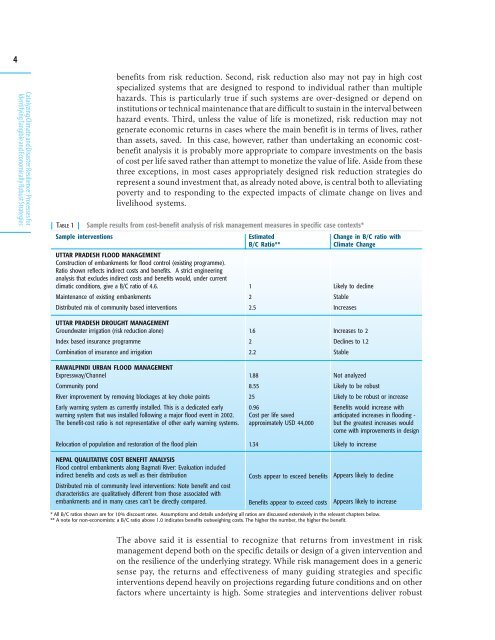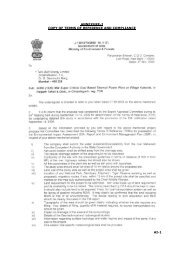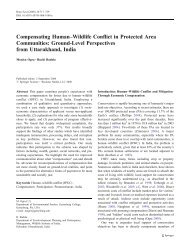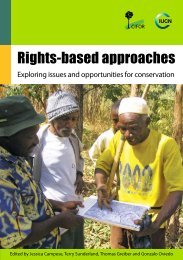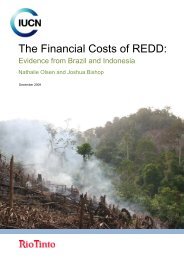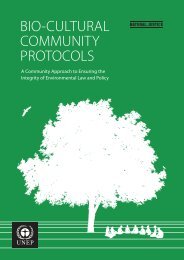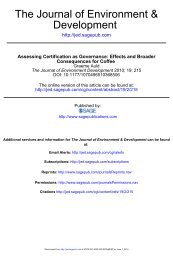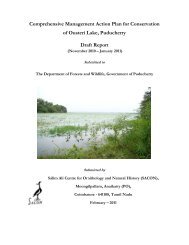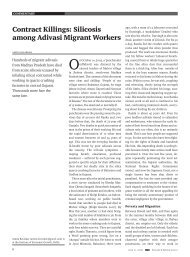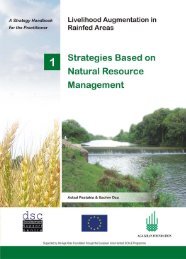Catalyzing Climate and Disaster Resilience: Processes for Identifying
Catalyzing Climate and Disaster Resilience: Processes for Identifying
Catalyzing Climate and Disaster Resilience: Processes for Identifying
Create successful ePaper yourself
Turn your PDF publications into a flip-book with our unique Google optimized e-Paper software.
4<br />
<strong>Catalyzing</strong> <strong>Climate</strong> <strong>and</strong> <strong>Disaster</strong> <strong>Resilience</strong>: <strong>Processes</strong> <strong>for</strong><br />
<strong>Identifying</strong> Tangible <strong>and</strong> Economically Robust Strategies<br />
benefits from risk reduction. Second, risk reduction also may not pay in high cost<br />
specialized systems that are designed to respond to individual rather than multiple<br />
hazards. This is particularly true if such systems are over-designed or depend on<br />
institutions or technical maintenance that are difficult to sustain in the interval between<br />
hazard events. Third, unless the value of life is monetized, risk reduction may not<br />
generate economic returns in cases where the main benefit is in terms of lives, rather<br />
than assets, saved. In this case, however, rather than undertaking an economic costbenefit<br />
analysis it is probably more appropriate to compare investments on the basis<br />
of cost per life saved rather than attempt to monetize the value of life. Aside from these<br />
three exceptions, in most cases appropriately designed risk reduction strategies do<br />
represent a sound investment that, as already noted above, is central both to alleviating<br />
poverty <strong>and</strong> to responding to the expected impacts of climate change on lives <strong>and</strong><br />
livelihood systems.<br />
| TABLE 1 | Sample results from cost-benefit analysis of risk management measures in specific case contexts*<br />
Sample interventions<br />
Estimated<br />
B/C Ratio**<br />
Change in B/C ratio with<br />
<strong>Climate</strong> Change<br />
UTTAR PRADESH FLOOD MANAGEMENT<br />
Construction of embankments <strong>for</strong> flood control (existing programme).<br />
Ratio shown reflects indirect costs <strong>and</strong> benefits. A strict engineering<br />
analysis that excludes indirect costs <strong>and</strong> benefits would, under current<br />
climatic conditions, give a B/C ratio of 4.6.<br />
Maintenance of existing embankments<br />
Distributed mix of community based interventions<br />
1<br />
2<br />
2.5<br />
Likely to decline<br />
Stable<br />
Increases<br />
UTTAR PRADESH DROUGHT MANAGEMENT<br />
Groundwater irrigation (risk reduction alone)<br />
Index based insurance programme<br />
Combination of insurance <strong>and</strong> irrigation<br />
RAWALPINDI URBAN FLOOD MANAGEMENT<br />
Expressway/Channel<br />
Community pond<br />
River improvement by removing blockages at key choke points<br />
Early warning system as currently installed. This is a dedicated early<br />
warning system that was installed following a major flood event in 2002.<br />
The benefit-cost ratio is not representative of other early warning systems.<br />
Relocation of population <strong>and</strong> restoration of the flood plain<br />
NEPAL QUALITATIVE COST BENEFIT ANALYSIS<br />
Flood control embankments along Bagmati River: Evaluation included<br />
indirect benefits <strong>and</strong> costs as well as their distribution<br />
Distributed mix of community level interventions: Note benefit <strong>and</strong> cost<br />
characteristics are qualitatively different from those associated with<br />
embankments <strong>and</strong> in many cases can't be directly compared.<br />
1.6<br />
2<br />
2.2<br />
1.88<br />
8.55<br />
25<br />
0.96<br />
Cost per life saved<br />
approximately USD 44,000<br />
1.34<br />
Costs appear to exceed benefits<br />
Benefits appear to exceed costs<br />
Increases to 2<br />
Declines to 1.2<br />
Stable<br />
Not analyzed<br />
Likely to be robust<br />
Likely to be robust or increase<br />
Benefits would increase with<br />
anticipated increases in flooding -<br />
but the greatest increases would<br />
come with improvements in design<br />
Likely to increase<br />
Appears likely to decline<br />
Appears likely to increase<br />
* All B/C ratios shown are <strong>for</strong> 10% discount rates. Assumptions <strong>and</strong> details underlying all ratios are discussed extensively in the relevant chapters below.<br />
** A note <strong>for</strong> non-economists: a B/C ratio above 1.0 indicates benefits outweighing costs. The higher the number, the higher the benefit.<br />
The above said it is essential to recognize that returns from investment in risk<br />
management depend both on the specific details or design of a given intervention <strong>and</strong><br />
on the resilience of the underlying strategy. While risk management does in a generic<br />
sense pay, the returns <strong>and</strong> effectiveness of many guiding strategies <strong>and</strong> specific<br />
interventions depend heavily on projections regarding future conditions <strong>and</strong> on other<br />
factors where uncertainty is high. Some strategies <strong>and</strong> interventions deliver robust


